| Daily Life |
Egyptian gods and goddesses
| Bes | 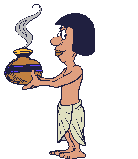 |
Isis | Sakhmet | |
| Ammut | Hapi | Kheper | Seth | |
| Anubis | Hathor | Osiris | Sobek | |
| Atum | Horus | Re | Thoth |
Egyptian Beliefs
Religion in ancient Egypt was not unlike modern times. Today, not everyone believes in the same way or the same god. Egypt was no different. Individual kings worshipped their own gods, as did priests, workers, merchants and peasants.
The ancient Egyptians were extremely devout in their beliefs. They were dedicated to their gods and worshipped them in many different ways. Religion was, therefore, intrinsic to all things in ancient Egyptian life. It incorporated prayer, magic and medicine, it was perfectly normal to treat an illness using all of these elements.
Certain gods were worshipped in different areas. Local cities or villages, known as nomes, worshipped unique gods that were only known to that region. On occasion, these gods attained country-wide recognition and became myths and legends that were passed down from century to century.
The kings of ancient Egypt were an integral part of religion. In pre-dynastic times the kings were considered to be gods. In later times, kings became "transformed into" gods. This was a crucial part of the governing of the people.
![]()
![]()
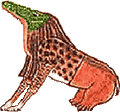
Ammut was a female demon from the Underworld who took care of punishment of sinners. She had a crocodile's head, a lion's mane, the front part of a leopard and the rear of a hippopotamus. All were very dangerous animals to people and feared by the Egyptians in all times. Ammut sat at the Osiris Court in the Underworld where the heart of the deceased was put on the scales against the feather of Ma'at. If the heart was heavy because of sins, Ammut would swallow it at once and the soul became restless forever, this was called: "to die a second time". Thus one of her names was "The Devourer". However, Ammut did not have a cult of her own (understandably), since she was a monster that people should fear if they did not live their lives according to the rules of ma'at - where one had to be honest, fair and truthful in life.
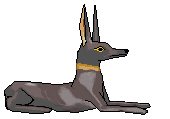

Anubis was sometimes represented as a jackal or a man with a jackal's head. He looked after the place of mummification and supervised the priests' embalming work. Anubis was the god of mummification and the dead.
![]()
Atum ("The Completed One") was the first god, a creator god at Heliopolis ("sun city" in Greek) and one of the "Nine deities" of Lower Egypt. He created everything (himself too) through masturbating or spitting on earth, and from one of his hands he made woman. He embodied the setting sun and was reborn every morning as the god Kheper. He could be seen in many forms, like a cat or an eel with a royal crown. His body was considered the parts of all physical matter and he was mostly seen as a man. When he was combined with a fellow god Re, he became Atum-Re. His wife was Nebhethotep (possibly sometimes called Akusaa), a rare deity, who like him symbolised the setting sun.
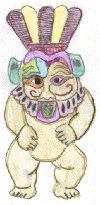
Bes in Egyptian also known as Bisu.
The dwarf Bes was a demigod from Babylonia and was imported to Egypt during the 18th dynasty (1550-1300 BC). Initially known as a war god in his homeland, in Egypt he became a protector against evil spirits and misfortune. He was depicted in a sometimes androgyne way, full face with a bearded large head, bow legs and sometimes a bushy tail. He scared off destructive powers using various musical instruments like rattles to make a din, swords and knives.
He aided Taueret as a midwife. When a child was born, he would stay by the cradle
and entertain it. As protector of the royal house, he became a very popular
household deity for all Egyptians. He had a plumed crown and wore the skin of a
lion or panther and was also the patron of fashion.
Sometimes he wore the mane of a lion and in a few pictures, he is looking rather
female, possibly by the (possibly misread) name Beset.
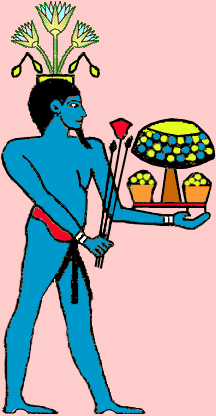
Hapi in Egyptian also Hap, Hep
Hapi was the god of the Nile itself, the very incarnation of wealth and the symbol of the life-giving fertile mud over the fields. He dwelled in a cave near the first cataract, where he was fed by crocodiles and frogs who wanted to assure themselves that the river Nile should never run dry. He was always depicted as a big fat man covered with (blue, black or green) mud from the river, offering fruits and flowers and carrying the symbols of the two Kingdoms: the Lotus and Papyrus. His festival was held in all parts of the country in the late summer when the flooding began, and his popularity was for obvious reasons constant through all times. His wife was the goddess Nekhbet.
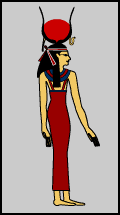
Hathor (meaning "the womb of Horus", her son) in Egyptian also Het, Hert, Heret
The cow goddess (the head of a cow) Hathor (Athyr in Greek) protected music, dancing, love and had seven forms. Wife to the sacred bull, Buchis. She and Horus protected the royal couple and she attended at the arrival of the dead king into the next world. On her head was seen her favourite musical instrument - a sistrum rattle. On top of pillars she was seen as Heret - a woman's head with a cow's ears. In the Old Kingdom the pharaohs were often shown with Hathor at their side. Sometimes she was combined with Isis as Isis-Hathor with a woman's head. One of the still standing temples of her cult is at Dendera in Upper Egypt. Hathor was also known as the goddess of the sky, mirth, joy, women, fertility and beauty.
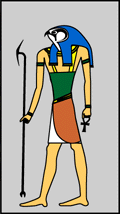
Horus was the son and avenger of Osiris. Falcon - headed Horus became king of Egypt after his father's death. He ruled justly and many temples were raised in his worship. Horus was the god of light, whose eyes were the sun and moon.
![]()
Isis (in Greek) was from Lower Egypt and stood for love, magic, motherhood, children, medicine and peace. She was first mentioned in writing in dynasty five pyramid texts and survived almost unchanged through Egyptian history. People asked her to make marriages happy, and with time she also joined the Osiris cult as his consort. She was the goddess with a throne upon her head and her name simply meant "seat". A popular motif was her sitting and nursing her son, Horus, giving him a meal. Like Hathor, she could also wear the sun disc within two cow-horns and a cobra. Her parents were Nut and Geb. Her temples were found all over Egypt and her very popular worshipping was continued by the Greeks and Romans.
It was common for important Egyptian deities to merge together in order to combine their various aspects for specific purposes. Deities also took on different guises according to their role. Therefore, the great goddess Isis became the goddess Hathor (meaning "the womb of Horus", her son) when she adopted the role of motherhood. In this guise she took the form of a cow. However, a deity could commonly have very different, even opposite, attributes. As well as being the cow of motherhood, Hathor is the goddess of whom Ra sent out to destroy mankind.
Isis was referred to as the "lady of heaven, mistress of the gods". Isis was the mother goddess of fertility and nature. She was one of the most important goddesses of ancient Egypt. Isis cared for Horus and hid him from his wicked uncle Seth, until he grew up. Seth murdered his brother, Osiris, and tried to kill his nephew, Horus, to get revenge for his father's death. Isis, the mother of Horus, used her magic to trick Seth.
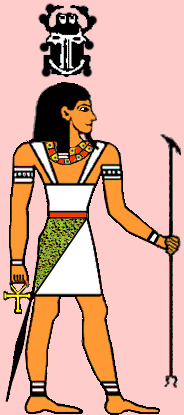
Kheper in Egyptian also Khepri
The old god Kheper ("to become") was the god of creation or more precisely - the rebirth, when he embodied the solar disk of Re, the sun god, that rose again every morning. Thus the scarab depicted above Kheper's head, was the symbol of creation and family happiness and was seen on jewellery and often placed on mummies. The Egyptians saw this beetle roll balls of dung, which became the symbol of the sun disc and identified with Re and stood for renewal, and transformation. His name was taken into the kings' names and he was depicted in two human ways or just as a scarab. No cult of his is known from the Old Kingdom, but scarab-amulets appear from the oldest times. Khepri was a man with a scarab head. The sacred scarab beetle found on his head was a symbol of how Kheper rolled the sun on the horizon, like the sacred scarab (dung beetle) rolls its dung across the ground before laying its eggs. Kheper renewed the sun each day and delivered it safely into the other world. Kheper represents the black sun, which is made by the new moon and is seen during an eclipse.
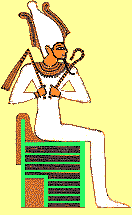
Osiris (in Greek) was king of the Underworld and originally a god of agriculture and nature. His origin is disputed and he first appeared during dynasty five. In Heliopolis, he was said to be son of Re and he represented the dead king. Minor gods were taken into his vast cult and many legends were told about him. The common Myth of Osiris is about his death (murdered by his brother Seth) and resurrection. He was the chief judge in the court at the threshold to the next life, where all the dead citizens were trying to come through to Paradise. He always wore a mummy-dress and was brother to Isis, Horus (the elder), Seth and Nephthys. His parents were Geb and Nut. Osiris was shown with a crown of reeds and ostrich feathers. He carried a crook and flail to show that he was king of the underworld.
![]()
Re (also spelt Ra) was the old solar-god from Heliopolis ("sun city" in Greek) and a major deity all over Egypt. He was the god of the sun and creator god. Re had a human form with a hawk head with a solar disk encircled by a uranius on his head. He was travelling over the sky in his boat every day with his life-giving sun disc. He stood for life, rebirth, children, health, virility etc, and the myths about him were several. His cult was pushed forward during the fifth dynasty when the pharaohs took the title - son of Re. During the New Kingdom, he was combined with Amon and became Amon-Re and Horus as Re-Horakhte. In later times, he got a wife called Ret, and she looked just like Hathor. One of the many aspects of him was called Atem.
![]()
Sakhmet (in Greek: Sachmis) was the popular fire-goddess, daughter of Re and associated with plagues and famines. Her husband was the old god Ptah of Memfis and her popularity was parallel to his, that is - through all the 3000-years of Egyptian history. In some places, Sakhmet was considered to have healing functions. She and Hathor once almost wiped out all humanity when Re told her to punish all those who had forgotten him. Sakhmet was shown as a woman with a head of a lioness and sometimes with the sun disc and /or a cobra on top of her head. Herself, her husband and son Nefertem formed the "Triad of Heliopolis". She had the power to destroy Egypt's enemies, killing them with the rays of the sun that she sometimes carried along. Sakhmet was the goddess of war, the "Eye of Re". She was known as the "Lady of Pestilence". Sakhmet's name means "the powerful one".
![]()
Seth The enemy of Osiris, his brother. Seth coveted the throne of Egypt for many years. It is said that after he killed Osiris, Seth cut the body into pieces before hiding them in 14 different secret locations. Seth was represented with a canine body, slanting eyes, square - tipped ears, tail and a long curved, pointed snout. He was the sky god, lord of the desert, master of storms, disorder and warfare. Seth embodied the necessary and creative element of violence and disorder, within the ordered world. Seth was admired and feared for his ferocity.
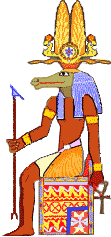
Sobek (or Sebek), a crocodile god from Faijum. He was born from the watery chaos, when the world was created. Sobek symbolised the physical strength of the king, the might of the Egyptian pharaoh and was bodyguard for other deities, protecting them from all evil. He stood for eternal time and in the pyramid texts, he was the son of Neith. At the end of the Middle Kingdom, kings from the Faijum, wore his name and tried to make his cult the state religion. In Kom Ombo, his temple still stands. In some places, he was equalled to the disorderly Seth, since the Egyptian feeling about crocodiles was ambivalent. When wearing the sun disk upon his head, he was a manifestation of Re, called Sobek-Re. He was considered a four fold deity, who represented the four elemental gods (Ra of fire, Shu of air, Geb of earth and Osiris of water).
![]()
Thoth (Greek), Egyptian DJHUTY, also spelt DJHOWTEY, in Egyptian religion, a god of the moon. Thoth was also known as the old god of wisdom, learning, fantasy, writing, wit, speaking and inventions. Thoth recorded everything and as a baboon, he checked (or "adjusted") the result at the "Balance of Truth" at the court of Osiris. He wore the head of an ibis-stork and carried his writing tools. He was associated with the moon (on his head). He protected physicians and knew of magic. He had a part in the Myth of Osiris and was called "the Silent Being", an irony to his protection of spoken words. His festival "lord of heavens" was held at the New Year. In the capital Khemenu, (Hermopolis), of province 15 of Upper Egypt, he was considered to be the creator of the World. Thoth was represented as an ibis or a baboon. He was the god of time, of measurement, the inventor of writing. Thoth means "truth and time".
| Daily Life |